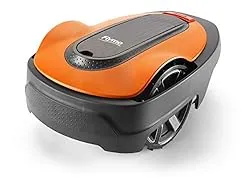Which Robot Lawn Mowers Work Without Perimeter Wires?
When you’ve just bought a brand-new robot lawn mower, the last thing you want to do is spend hours burying a perimeter wire around the edge of your lawn.
But unlike robot vacuums which have walls and objects to work from, a lawn doesn’t afford such luxuries.
Unfortunately, there aren’t currently any robot lawn mowers without a perimeter wire. However, things should soon change as manufacturers start to look at incorporating GPS or beacons in the design.
In the rest of this guide, I’ll explain the possible ways a mower could work without a perimeter wire and some hassle-free tips for creating your boundary.
Table Of Contents
- What Is a Perimeter Wire?
- Are There Any Robot Mowers Without Perimeter Wire?
- What’s the Best Robot Mower?
- Why Are There No Robot Mowers Without Perimeter Wire?
- How Might a Robot Mower Work Without a Perimeter Wire?
- Why is a Perimeter Cable a Problem?
- Tips for Placing Your Robot Mower’s Perimeter Wire
What Is a Perimeter Wire?
A perimeter wire is a cable that you need to place around the edge of your lawn before you allow your robot mower to roam loose.
They usually need to be powered and must be in a complete circuit, starting and ending at the charging base of the mower.
As well as detecting the edges of a lawn, the perimeter cable helps the mower navigate back to the base station at the end of a cut.
Are There Any Robot Mowers Without Perimeter Wire?
Whilst there are a few robot mowers that don’t need a perimeter wire, I wouldn’t recommend you jump to purchase them just yet.
Ambrogio is a brand that has embraced GPS robot mowers such as the Ambrogio L400i Deluxe that doesn’t require a perimeter wire. However, it is designed for commercial use so would set you back around £14k, not ideal.
They have attempted a domestic mower, the Ambrogio L60, however this doesn’t use GPS and relies on its onboard sensors to detect when there is grass underneath and where there are drops such as flowerbeds.
Needless to say, the technology isn’t quite there so its performance is very flaky. Also, it doesn’t have a charging base, so you manually need to take it out and collect it for charging.
I will be keeping a close eye on the market and as soon as there is a robot mower that works without a perimeter cable, I’ll update this article.
What’s the Best Robot Mower?
My current top pick is the Flymo Easilife range which offers a good mix of performance and affordability.
There are models for lawns of 200sqm, 350sqm and 500sqm.
The mower can automatically adjust it’s mowing schedule according to the weather, or you can set your own in the companion app (requires a Bluetooth connection).
Find out more about this and other models in my guide to the best robot mowers in the UK.

Why Are There No Robot Mowers Without Perimeter Wire?
Whilst Ambrogio have shown that the technology exists, it comes down to the cost of incorporating this into new devices whilst keeping them affordable.
As demand for robot mowers grows and the cost of the components decreases, we’ll hopefully start to see some GPS robot mowers or other innovations such as those suggested below.
How Might a Robot Mower Work Without a Perimeter Wire?
There are actually a number of methods that manufacturers could use to build a robot mower that doesn’t need a perimeter cable, some are suggested below:
1. Onboard Sensors
As noted in the example of the Ambrogio L60, onboard sensors are one method a mower could use to identify the edges without any boundary wire.
Using the onboard sensors, a mower can detect moisture from grass compared to hard surfaces as well as using cliff sensors to identify drops.
Optical wheel tracking and gyroscopes can also be used to calculate how far a mower has travelled and where it is relative to it’s charging base.
This is the most affordable option for manufacturers to use, however it’s probably the least reliable and will require perfect gardens to function.
2. GPS
GPS has long been used in professional robot mowers designed for large areas such as football pitches or public parks. The Ambrogio L400i Deluxe mentioned earlier is a prime example of this.
The accuracy of GPS can vary greatly depending upon where you are located, but anything between 1m to 3m is often cited.
This is fine for large areas of grass like football pitches as the edges can be picked up manually. However, it’s not accurate enough for most domestic lawns.
Some robot mowers for domestic use do include GPS, but this is usually as a theft prevention feature that will set off an alarm and render it useless if take beyond the boundary of your home.

3. Lasers or vSLAM
An alternative route that manufacturers could take it to drawn on technology used in robot vacuums.
This will use either vSLAM (visual cameras), laser navigation or a combination of the two.
Vacuums have an advantage of operating in a closed room with plenty of objects to use for navigating, however we’re increasingly seeing the use of AI to improve their navigation skills which could be leveraged outside in robot mowers.
It’s not hard to imagine a robot mower that is able to use AI to identify flower beds, patios and other edges.
4. WiFi or Radio Beacons
Beacons are a technology usually associated with indoor navigation as they are more accurate than GPS and don’t need signal to operate.
This would use one or more beacons around your lawn and the mower would calculate how long the signals take to reach it to determine its position.
iRobot, best known for their Roomba, announced that they were developing a robot mower that uses beacon technology without the need for a perimeter wire, but that has yet to be launched.
Why is a Perimeter Cable a Problem?
You might be wondering why there is a need for a robot mower without a perimeter cable.
Well, you only realise how much of a hassle they are when you have one, here are three reasons why we’d be better off without:
-
Takes a long time to bury the cable.
-
Can be problematic if you need to move or rearrange the perimeter.
-
If the wire breaks it will no longer function as it must be a complete circuit, it can be a hassle to fix as finding the break is hard once you have buried the cable.
Tips for Placing Your Robot Mower’s Perimeter Wire
So, whilst we are all destined to have a perimeter wire for the foreseeable future, here are a few tips to help you when laying the boundary cable and setting up your robot mower:
Be sure to check the instructions for laying the boundary - You shouldn’t lay it right at the edge of the lawn as the mower needs room to manoeuvre. Usually around 10cm will be suitable.
Place the charging base first – The charger will be where the boundary cable starts and ends, this should be close to a power source and you may want to consider somewhere that you can buy or build a robot mower garage.
Bury the cable to avoid an eyesore – If you’re worried about the cable being an eyesore, you can bury it just below the surface at around 5cm deep. Be sure to check the instructions for each mower.
You may want to test the cable before burying it – Before burying the cable, give it a test run on the surface to make sure everything is okay. You don’t want to dig it up again to reposition.
Secondary areas – If you need to cover two lawns, be sure to plan out the boundary cable beforehand. The same cable may need to be used for both lawns and may need to pass between them somehow.